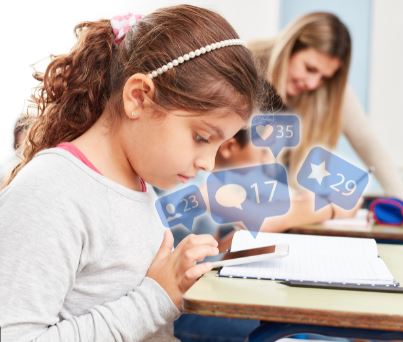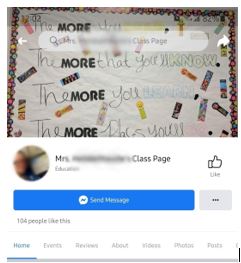Bicen and Aydogan demonstrate that elements of gamification can be an effective way for parents and students to connect. In their study, they worked with 2 groups of parents as they took part in a gamification process to see their response in regards to education, but also on communication with their students. "It was determined that the parents were happy during the education because they learned useful practices for their children: (190, 2020). Parents were not only engaged with their own learning, but also about how this caused them to have insights into their children's learning and gave them a way to connect with their children. Gamification is common on blockchain applications as many of the social media platforms have gamification elements in their badges and incentives.
So if we know that gamification can be a way to engage students and parents, what about the other aspects of social media? Can they be useful in the classroom, or are they more of a distraction for students? I know in my own classroom experience, many times I was frustrated with students being distracted by social media during the school day. If a student updated their relationship status on their profile between classes, it was not out of the question to lose some class time during the next period as students processed the new information in the school relationship web of connectedness. How do we balance that distraction deficit with the engagement potential. We start by listening to our students. Social media is important to many of our students. Katie Benmar explains, "[a]s teens, my peers and I feel the constant need to stay connected to everyone around us, and the main way of doing this is through apps like Instagram and Facebook" (2015). Katie goes on to explain:
The best teachers I’ve ever had have used technology to enhance learning, including using Facebook pages for upcoming projects or planned online chats about books we read in class. These teachers were interesting to listen to, and the projects were fun and challenging. Online discussions using code names replaced book reports. And the thing is, participating in a discussion with other people didn’t require any less thought about the book than writing a book report would have. It actually made me think about it and understand it better, because I was listening and responding to other people’s opinions that were backed up with evidence, instead of following the same strict book-report format that I had been required to do for years.
(2015). So just like gamification can increase engagement and give us new ways to communicate with our students (and parents) so can the other aspects of social media.
Irene Bal, a lecturer in the Educational Technology Program at Loyola University, explains that it is important to determine your "why" so that you have a guide for your social media interaction. “Why do you want to integrate social media into your classroom? And then beyond the why, how will you use it? To share resources? To host chats? To connect your students to other students? You need to be specific about what activities, standards, and content will be tied to your social media activities. (Loyola School of Education, 2018).
Like so much in education, there is an important learning curve if you plan to include this in your classroom. You'll need to be confident in your security settings. How you set those up is going to be dependent on how you answer your "why" questions. Do you want your students to be able to connect with students from all over the world? Do you want parents to be involved in any way? Are you protecting your students privacy when they interact through your social media page? Spend some time on the app's Settings Page to be sure you are effectively managing those privacy concerns. Once you have those mastered, social media can be an effective tool for building parent and student engagement, continuing and improving class discussions, and keeping assignments at the top of student's minds.
Social media is an important part of our students' lives and it isn't going away. Teacher's that successfully integrate social media into their toolbelt are improving their communication and expanding their strategies to help students become successful citizens (and digital citizens).
References
Benman, Katie. (2015, April 21). My Favorite Teachers Use Social Media: A Student Perspective. Education week. https://www.edweek.org/technology/opinion-my-favorite-teachers-use-social-media-a-student-perspective/2015/04?s_kwcid=AL!6416!3!156092717260!b!!g!!&cmp=cpc-goog-ew-dynamic+ads&ccid=dynamic+ads&ccag=technology+dynamic&cckw=&cccv=dynamic+ad&gclid=Cj0KCQjwppSEBhCGARIsANIs4p71BmWqctisSaWqoi1XFidvlvE3_0hhjqzUxpCb015-x2fdqSPpdZMaAk0NEALw_wcB
Bicen, H. and Aydogan, K. (2020) Gamification Education for Parents: Effects on Motivation and Communication. Revista De Cercetare Si Interventie Sociala. Volume 69.
Loyola School of Education. (2018). Social Media: An Asset in the Classroom. Loyola University. https://www.loyola.edu/school-education/blog/2018/social-media-an-asset-in-the-classroom#:~:text=It%20helps%20gets%20the%20word,programs%2C%20and%20acknowledge%20student%20awards
Photo Credit: Social Media Explorer


It makes sense that the design thinking process involved in creating innovative curriculum with social media would center around empathizing with the students, then constructing creative solutions based on their needs and interests. I also appreciate your highlighting the importance of first determining the purposes behind using social media, as well as how to build that into the curriculum, to support important learning goals in the classroom. As you also mention, I would think considering security and privacy issues to be particularly important, especially when working with young children or pre-teens/teens. It is also good to know that if the social media platform can’t rely on the security assurances provided on blockchain, at least there are app settings that can help establish those safeguards.
I think Social Media can effectively be used in some classrooms, especially in High School. However, I wonder how Blockchain media sites such as HIVE can and should be incorporated. Although they do provide more security, would most students be able to handle the responsibility of managing their secure login information? Blockchain sites such as HIVE do not allow for retrieval of user login information with email or cell phone codes being sent. Do they benefits of Blockchain Social Media use with K-12 students outway the cons?
I don't think we're there yet. Blockchain social media is still pretty clunky in terms of the user experience. I don't see students being able to navigate effectively.